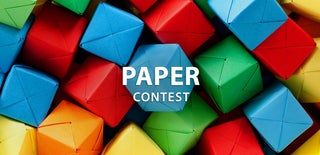Introduction: Cardboard View Screen
My kids have recently converted a couple of empty boxes into a spaceship. I made them a view screen out of boxes from filament spools - and so can you!
You can easily print any number of images for the view screen to show. I picked a few from NASA's Astronomy Picture of the Day to begin with, but I imagine there will be more Sci-Fi additions soon.
Step 1: Materials and Tools
Here is what you need, but keep in mind that this was hastily cobbled together (with care), so if you can get it done in another way you should go for it!
Materials
- 2 filament boxes - if you 3D-print things you probably have a number of these boxes at hand. The idea here is that they are of the same dimensions to make things easier. Plain Cardboard could work as well.
- transparency, 1 sheet - not entirely necessary, but makes it a lot easier to insert images. Also, it adds reflections.
- tape, transparent - to attach things that need attaching.
- very optional: aluminum tape - to make the screen more futuristic.
Tools
- scissors - to cut things.
- hobby knife - also to cut things, optional but helpful.
Step 2: Cutting Up the Boxes
There are a couple of things that need to be cut on both boxes to combine them into a window to the great void between the stars. Check the pictures for roughly a thousand words.
Box 1:
Cut a screen-shaped hole into the lid of the first box. I chose a slightly "bowed" screen with curved outlines, but that is a matter of taste.
Make short cuts into the edge opposite to where the lid is attached. Fold that back and mae sure to crease the fold thoroughly.
Then, cut the front face in half to open up a flap. Really, look at the picture. I can't put that into words well enough.
Box 2:
Cut off the lid. Then shorten the flaps on three sides. Again, check the image.
Step 3: Optional: Aluminum Tape
This is something I did not do, but I think it would make the finished screen look a lot better. Use a bit of aluminum tape along the edges of the screen to make it look really futuristic. Other colors work as well. Black and white are probably most prominent in space ship design, but who says green, blue or pink are off the table?
Step 4: Screen for Easier Use
After trying to insert a piece of paper I realized that it would be hard to easily insert it without getting stuck on the way. To eliminate this problem, cut a piece of transparency to fit the screen. Then, glue it in place using four strips of transparent tape.
Step 5: Inserting the Separator
Now, insert the former lid of box 2 as shown in the picture. You need to leave enough room between the cardboard and the transparency for an image to be inserted. Ten, tape the side flaps in place using decent lengths of transparent tape. Honestly, at this point, you could use non-transparent tape, but the one you needed before anyway will work just as well.
Step 6: Closing the Box
Make sure that the side flaps slide into the box, then carefully push the whole thing shut. Make sure that the edge that you folded in on itself stays folded that way. This should make for a good friction fit to keep the box closed. Do not insert the last flap (hard to describe, but again, see pictures). You can easily pull it back out if you did, but you still need to access the openings.
Step 7: One Last Flap
Remember the edge that you folded over and creased thoroughly? The idea is to have it go over the cardboard back that you just inserted. After you have it in place, use another length of transparent tape to hold it in place.
Step 8: On Screen!
Now for the fun part (also known as rabbit hole). Measure the opening for the screen. Mine is 20 x 20 cm (or 4 x 4 inches). I printed a couple of images from Astronomy Picture of the Day and cut them to size, except for leaving a strip on top as a handle..
Alternative options:
- take scenic images from science fiction movies and shows
- same goes for spaceships an alien species making contact
- draw diagrams that represent sensor readouts or planetary scans
Step 9: Onwards!
And with that, the whole thing is done. Hand it to your kids to play with or use it yourself. I know I have. Purely for quality testing purposes, of course.
I would love to see pictures of your view screens, so use the feature below to share them with everyone!

Participated in the
Paper Contest













